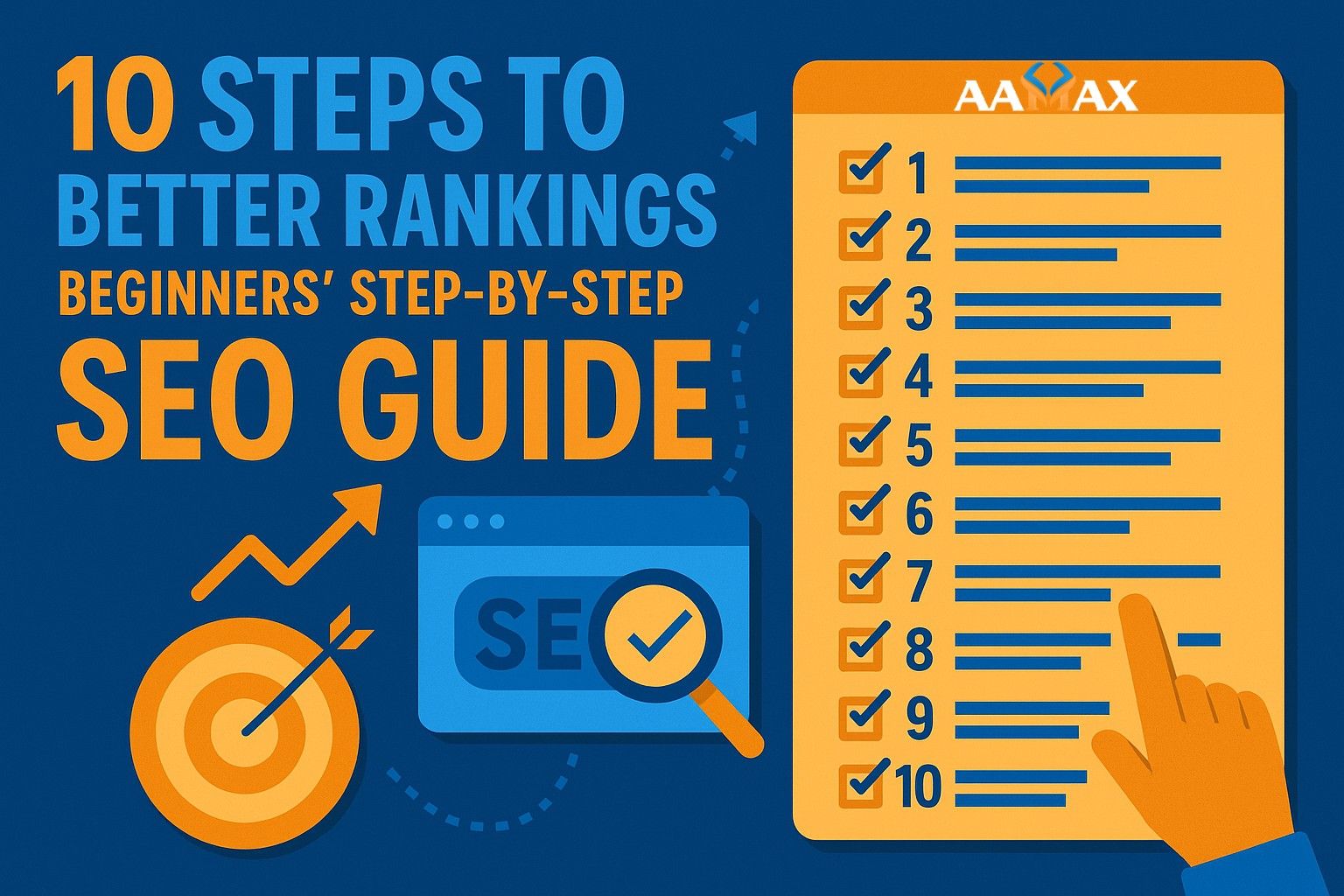
10 Steps to Better Rankings: Beginners' Step-by-Step SEO Guide
Are you looking to get your website noticed on Google and other search engines?Search Engine Optimization (SEO) can seem overwhelming, especially if you’re just starting out. But don’t worry! With the right guidance, you can start improving your website’s visibility step by step.
This beginner-friendly guide covers 10 essential steps to boost your website rankings organically. Whether you’re a small business owner, blogger, or digital marketer, these strategies will help you understand how SEO works and how to apply it effectively.
Let’s dive in!
Step 1: Understand What SEO Really Is
Before doing anything, it’s crucial to understand what SEO means.
SEO is the process of optimizing your website and content to appear higher in search engine results pages (SERPs). It includes several techniques, from choosing the right keywords to improving site speed and user experience.
Why does this matter? Because higher visibility in search results drives more organic traffic to your site, which can lead to more leads, sales, and brand awareness.
Remember, SEO isn’t about tricking Google; it’s about providing value to your audience and making your site search-engine-friendly.
Step 2: Start with Keyword Research
Keywords are the foundation of any SEO strategy.
What are keywords?
Keywords are words or phrases people type into search engines when looking for information, products, or services.
How to do keyword research:
-
Use free tools like Google Keyword Planner, Ubersuggest, or AnswerThePublic.
-
Identify terms with decent search volume and low to moderate competition.
-
Think about what your audience would search for when looking for your products or services.
Example:
If you run a baking blog, potential keywords could include “easy chocolate cake recipe,” “how to bake sourdough,” or “best baking tools for beginners.”
Pro tip: Focus on long-tail keywords (more specific phrases, e.g., “how to bake gluten-free bread”) as they often have less competition and attract more targeted traffic.
Step 3: Optimize Your On-Page SEO
Once you have your keywords, it’s time to optimize your pages.
Here’s what on-page SEO includes
-
Title tags: Use your main keyword naturally in the page title.
-
Meta descriptions: Write compelling summaries that include the keyword to encourage clicks.
-
Headings: Use H1, H2, and H3 tags to structure your content. Include keywords where it makes sense.
-
URL structure: Keep URLs short, readable, and include the target keyword.
-
Image optimization: Use descriptive file names and add alt text to images for better accessibility and SEO.
-
Internal linking: Link to other relevant pages on your site to help search engines understand your content hierarchy.
Example:
Instead of a generic title like “Home”, use “Easy Chocolate Cake Recipe | Bake Delicious Cakes at Home.”
Step 4: Create High-Quality Content
Search engines prioritize websites that publish original, valuable, and well-structured content.
What makes content high quality?
-
Addresses user intent: Solves the problem or answers the question the user has.
-
Is easy to read: Use short paragraphs, bullet points, and clear headings.
-
Updated regularly: Fresh content signals to Google that your site is active.
-
Adds value: Include original research, case studies, videos, infographics, or expert opinions.
Content types to consider:
-
Blog posts and articles
-
How-to guides and tutorials
-
Product pages with detailed descriptions
-
FAQs
-
Videos and infographics
Tip: Focus on E-E-A-T (Experience, Expertise, Authoritativeness, and Trustworthiness). It helps build credibility and rank higher.
Step 5: Improve Your Website’s Technical SEO
Technical SEO ensures search engines can crawl and index your site easily.
Key areas to check:
-
Mobile-friendliness: Your site must look and work well on smartphones and tablets.
-
Site speed: Slow websites frustrate users and harm rankings. Use tools like Google PageSpeed Insights to test and optimize loading times.
-
Secure connection: Use HTTPS to keep your site secure.
-
XML sitemap: Helps search engines find and index your pages.
-
Robots.txt file: Controls which parts of your site search engines can crawl.
Even beginners can handle some technical tasks, but you might need help from developers for advanced issues.
Step 6: Build Quality Backlinks
Backlinks (links from other websites to yours) are like votes of confidence in your content.
How to earn backlinks:
-
Create shareable content like guides, infographics, and original research.
-
Guest post on reputable blogs in your niche.
-
Collaborate with influencers or industry experts.
-
List your site in trusted directories.
Focus on quality over quantity. A few links from reputable sites are worth more than dozens from low-quality sites.
Tip: Avoid buying links. It can lead to penalties from Google.
Step 7: Use Local SEO (If Relevant)
If you have a local business, local SEO is essential.
How to optimize for local SEO:
-
Create and verify your Google Business Profile.
-
Include your business name, address, and phone number (NAP) consistently across your website and directories.
-
Encourage satisfied customers to leave reviews on Google and other platforms.
-
Create location-specific pages on your site.
Example:
If you run a bakery in Chicago, optimize for terms like “best chocolate cake in Chicago.”
Step 8: Track Your Performance
You can’t improve what you don’t measure.
Tools to use:
-
Google Analytics: See how visitors find and interact with your website.
-
Google Search Console: Check which keywords your site ranks for and identify indexing issues.
-
SEO tools like Ahrefs, SEMrush, or Moz to analyze backlinks, track rankings, and monitor competitors.
Key metrics to track:
-
Organic traffic
-
Bounce rate
-
Average time on page
-
Conversion rate
-
Keyword rankings
Use this data to identify what’s working and where you need to improve.
Step 9: Stay Updated and Keep Learning
SEO isn’t a one-time task. Search engines update their algorithms frequently.
How to keep up:
-
Follow trusted SEO blogs like Moz Blog, Search Engine Journal, or Backlinko.
-
Join online communities and SEO forums.
-
Take online courses or attend webinars.
-
Experiment with new techniques and track the results.
The more you learn, the better decisions you can make to grow your website’s visibility.
Step 10: Consider Professional Help When Needed
SEO can be complex, especially if you’re managing a large website or facing technical issues.
A professional digital marketing agency like AAMAX can help you:
-
Develop and implement a tailored SEO strategy.
-
Handle technical SEO and website development.
-
Create high-quality content and manage digital marketing campaigns.
AAMAX is a full-service digital marketing company offering Web Development, Digital Marketing, and SEO Services to help your business grow online effectively.
Investing in professional support can save time and deliver better results faster.
Final Thoughts
SEO is one of the most effective digital marketing strategies, but it requires patience, consistency, and ongoing effort.
Here’s a quick recap of the 10 steps:
-
Understand SEO basics
-
Do keyword research
-
Optimize on-page SEO
-
Create quality content
-
Improve technical SEO
-
Build backlinks
-
Use local SEO
-
Track performance
-
Keep learning
-
Get expert help when needed
Remember: Results don’t happen overnight, but by following these steps, you’ll build a strong foundation for long-term success.
Start applying what you’ve learned today, and watch your website rise in the search results!







